tow HONDA S2000 2000 1.G Owners Manual
[x] Cancel search | Manufacturer: HONDA, Model Year: 2000, Model line: S2000, Model: HONDA S2000 2000 1.GPages: 273, PDF Size: 21.58 MB
Page 1 of 273
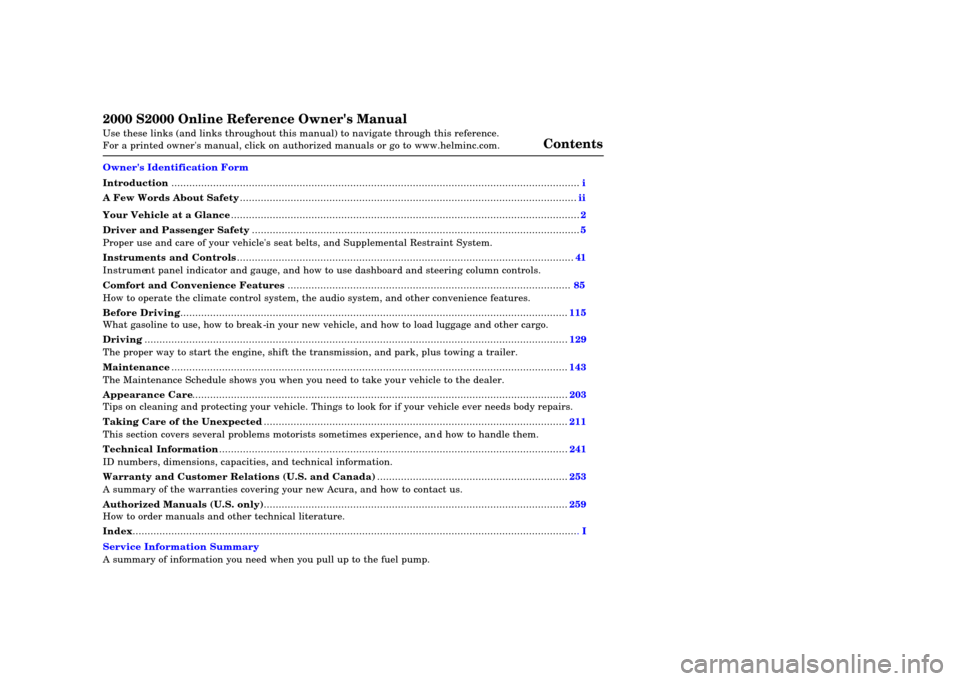
2000 S2000 Online Reference Owner's Manual Use these links (and links throughout this manual) to navigate through\
this reference.
For a printed owner's manual, click on authorized manuals or go to www.h\
elminc.com.
Contents
Introduction ........................................................................\
................................................................. i
A Few Words About Safety........................................................................\
........................................ .ii
Your Vehicle at a Glance........................................................................\
............................................ .2
Driver and Passenger Safety ........................................................................\
......................................5
Proper use and care of your vehicle's seat belts, and Supplemental Restr\
aint System.
Instruments and Controls........................................................................\
........................................ .41
Instrument panel indicator and gauge, and how to use dashboard and steering colu\
mn controls.
Comfort and Convenience Features ........................................................................\
....................... 85
How to operate the climate control system, the audio system, and other c\
onvenience features.
Before Driving........................................................................\
..........................................................115
What gasoline to use, how to break-in your new vehicle, and how to load luggage and other cargo.
Driving ........................................................................\
..................................................................... .129
The proper way to start the engine, shift the transmission, and park, pl\
us towing a trailer.
Maintenance........................................................................\
.............................................................143
The Maintenance Schedule shows you when you need to take yo ur vehicle to the dealer.
Appearance Care........................................................................\
..................................................... .203
Tips on cleaning and protecting your vehicle. Things to look for if your\
vehicle ever needs body repairs.
Taking Care of the Unexpected........................................................................\
..............................211
This section covers several problems motorists sometimes experience, a nd how to handle them.
Technical Information........................................................................\
............................................ .241
ID numbers, dimensions, capacities, and technical information.
Warranty and Customer Relations (U.S. and Canada)................................................................253
A summary of the warranties covering your new Acura, and how to contact \
us.
Authorized Manuals (U.S. only)........................................................................\
..............................259
How to order manuals and other technical literature.
Index........................................................................\
........................................................................\
...... I
Service Information Summary
A summary of information you need when you pull up to the fuel pump. Owner's Identification Form
Page 91 of 273
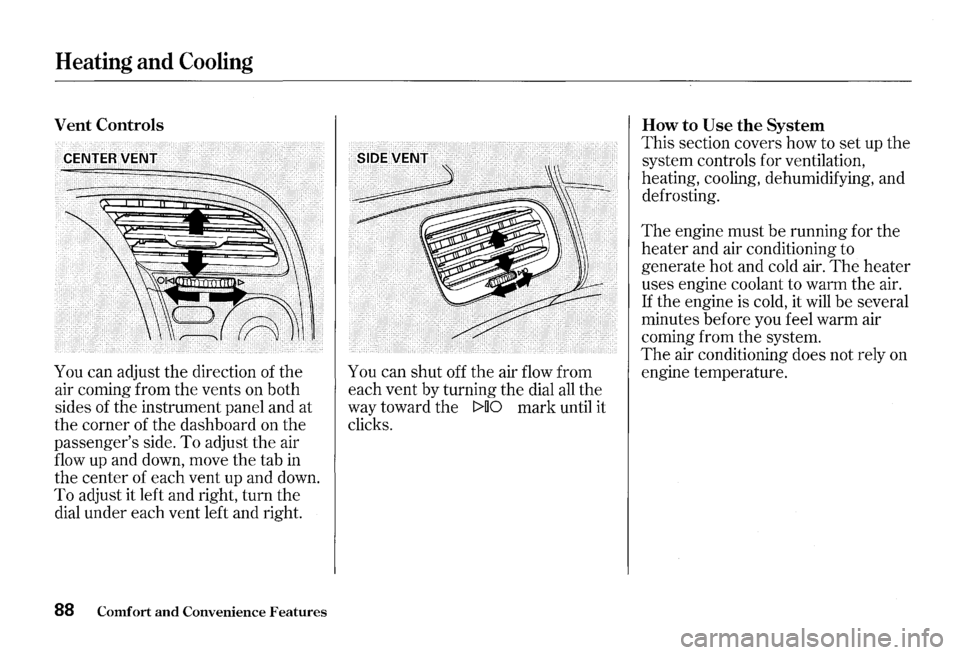
Heating and Cooling
Vent Controls
You can adjust the direction of the
air coming from the vents on both
sides of the instrument panel and at
the corner of the dashboard on the
passenger's side.
To adjust the air
flow up and down, move the tab
in
the center of each vent up and down.
To adjust it left and right, turn the
dial under each vent left and right.
88 Comfort and Convenience Features
You can shut off the air flow from
each vent by turning the dial
all the
way toward the
t>UO mark until it
clicks. How
to Use the System
This
section covers how to set up the
system controls for ventilation,
heating, cooling, dehumidifying, and
defrosting.
The engine must be running for the
heater and air conditioning to
generate hot and cold air.
The heater
uses engine coolant to warm the air.
If the engine is cold, it will be several
minutes before you feel warm air
coming from the system.
The air conditioning does not rely on
engine temperature.
Page 122 of 273

3. Pull the support rod out of its clip
and insert
the end into the hole on
the front of the hood around the
center.
To close the hood, lift it up slightly
to remove
the support rod from
the hole. Put the support rod back
into its holding clip. Lower
the
hood to about a foot (30 em) above
the fender, then let it drop.
After closing
the hood, make sure
it is securely latched.
Oil Check
Check the engine oil level every time
you
fill the car with fuel. Wait a few
minutes after turning
the engine off
before you check
the oil.
1. Remove the dipstick (black
handle).
Service Station Procedures
2. Wipe the dipstick with a clean
cloth
or paper towel.
CONTINUED
Before Driving 119
Page 127 of 273
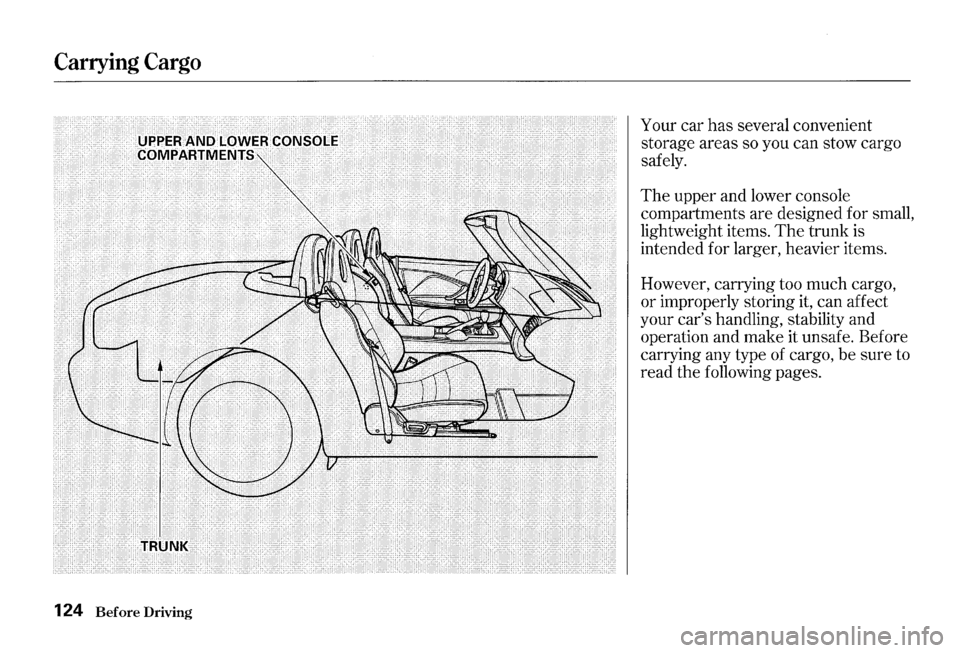
Carrying Cargo
124 Before Driving
Your car has several convenient
storage areas so you can stow cargo
safely.
The upper and lower console
compartments are designed for small,
lightweight items.
The trunk is
intended for larger, heavier items.
However, carrying too much cargo,
or improperly storing
it, can affect
your car's handling, stability and
operation and make it unsafe. Before
carrying any type of cargo, be sure to
read the following pages.
Page 132 of 273
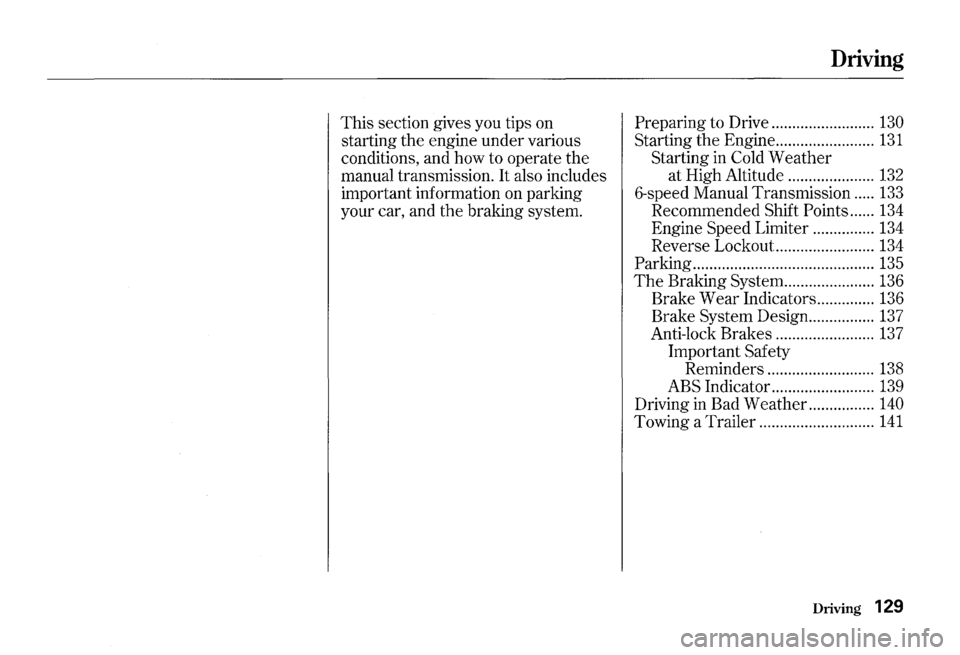
This section gives you tips on
starting the engine under various
conditions, and how to operate the
manual transmission.
It also includes
important information on parking
your car, and
the braking system.
Driving
Preparing to Drive ......................... 130
Starting the Engine ........................ 131
Starting in Cold Weather
at High Altitude .....................
132
6-speed Manual Transmission ..... 133
Recommended Shift Points ...... 134
Engine
Speed Limiter ............... 134
Reverse Lockout.. ...................... 134
Parking ............................................ 135
The Braking System ...................... 136
Brake Wear Indicators ..............
136
Brake System Design ................ 137
Anti-lock Brakes ........................ 137
Important Safety
Reminders ..........................
138
ABS Indicator ......................... 139
Driving in Bad Weather ................ 140
Towing a Trailer ............................ 141
Driving 129
Page 138 of 273
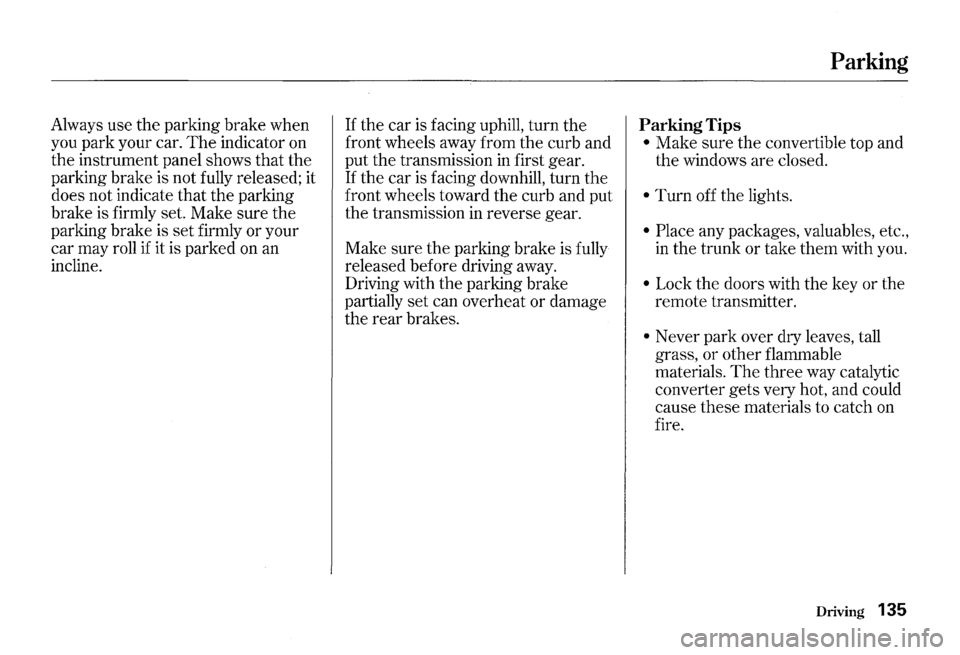
Always use the parking brake when
you park your car.
The indicator on
the instrument panel shows that the
parking brake is not fully released; it
does not indicate that the parking
brake is firmly set. Make sure the
parking brake is set firmly or your
car may roll
if it is parked on an
incline. If
the car is facing uphill, turn the
front wheels away from the curb and
put
the transmission in first gear.
If the car is facing downhill, turn the
front wheels toward the curb and put
the transmission
in reverse gear.
Make sure the parking brake is fully
released before driving away.
Driving with the parking brake
partially set can overheat or damage
the rear brakes.
Parking
Parking Tips
• Make sure the convertible top and
the windows are closed.
• Turn off the lights.
• Place any packages, valuables, etc.,
in the trunk or take them with you.
• Lock the doors with the key or the
remote transmitter.
• Never park over dry leaves, tall
grass, or other flammable
materials.
The three way catalytic
converter gets very hot, and could
cause these materials to catch on
fire.
Driving 135
Page 144 of 273

Traction -Check your tires
frequently for wear and proper
pressure. Both are important
in
preventing "hydroplaning" (loss of
traction on a wet surface). In the
winter, mount snow tires on all four
wheels for the
best handling.
Watch road conditions carefully,
they can change from moment to
moment. Wet leaves can be as
slip
pery as ice. "Clear" roads can have
patches of ice. Driving conditions
can be very hazardous when the
outside temperature is near freezing.
The road surface can become
covered with areas of water puddles
mixed with areas of ice, so your
traction can change without warning.
Be careful when downshifting. If
traction is low, you can lock up the
drive wheels for a moment and cause
a skid.
Driving in Bad Weather, Towing a Trailer
Be very cautious when passing, or
being passed by other cars.
The
spray from large cars reduces your
visibility, and the wind buffeting can
cause you to lose control.
Towing a Trailer
Your car is not designed to tow a
trailer. Attempting to
do so can void
your warranties.
Driving 141
Page 180 of 273
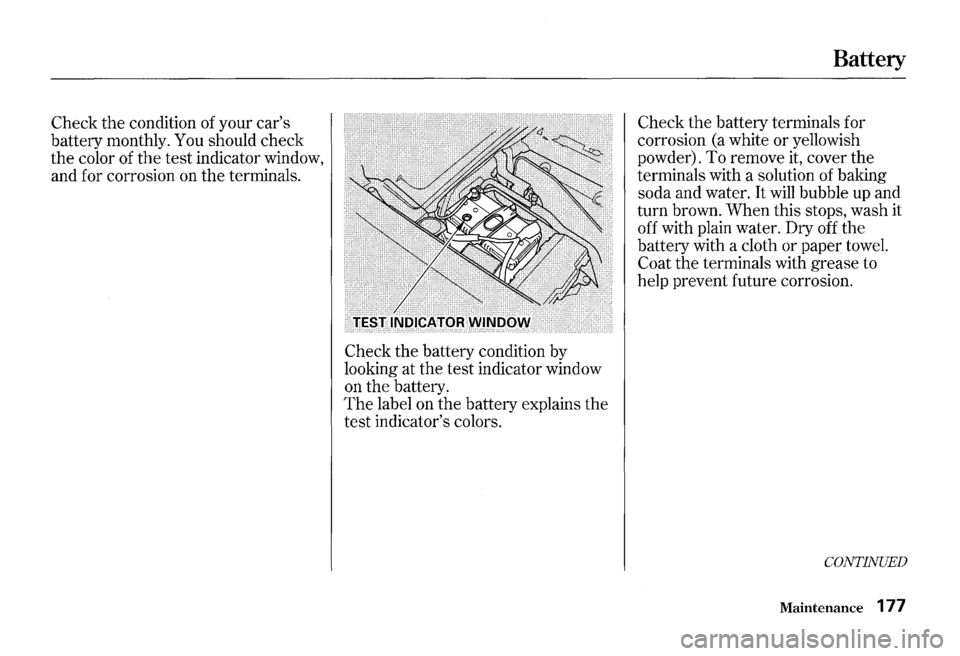
Check the condition of your car's
battery monthly. You should check
the color of
the test indicator window,
and for corrosion on
the terminals.
Check
the battery condition by
looking at the test indicator window
on the battery.
The label on the battery explains the
test indicator's colors.
Battery
Check the battery terminals for
corrosion (a white or yellowish
powder).
To remove it, cover the
terminals with a solution of baking
soda and water.
It will bubble up and
turn brown. When this stops, wash it
off with plain water. Dry off the
battery with a cloth or paper towel.
Coat the terminals with grease to
help prevent future corrosion.
CONTINUED
Maintenance 177
Page 183 of 273

Wiper Blades
Check the condition of the wiper
blades at least every six months.
Look for signs of cracking in
the
rubber, or areas that are getting
hard. Replace
the blades if you find
these signs, or they leave streaks
and unwiped areas when used.
180 Maintenance
To replace the blade:
1. Raise the wiper arm off the
windshield.
2. Disconnect the blade assembly
from
the wiper arm by pushing in
the lock tab. Hold it in while you
push
the blade assembly toward
the base of the arm.
Page 205 of 273
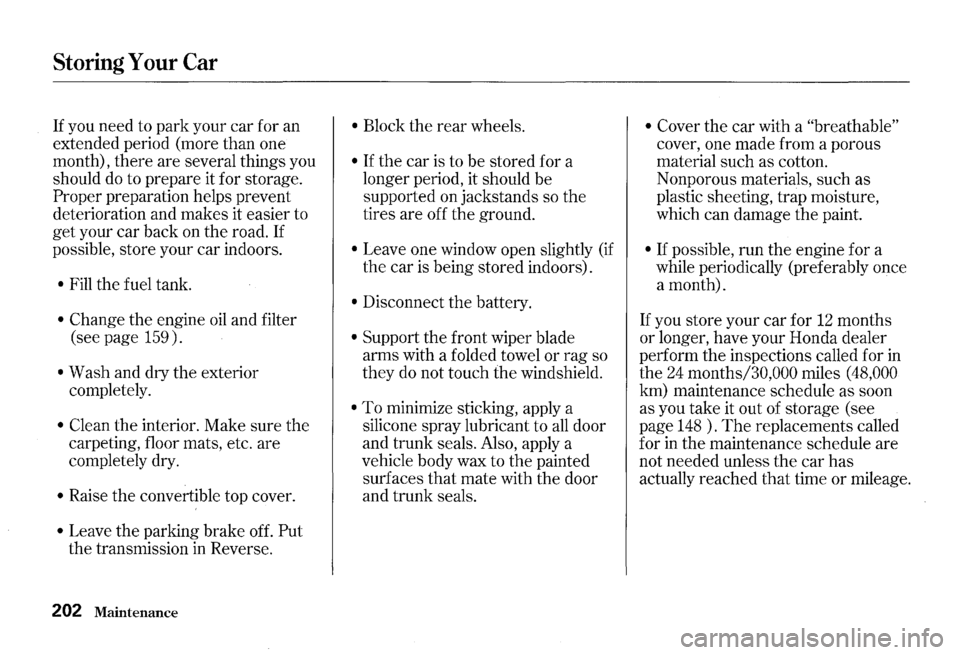
Storing Your Car
If you need to park your car for an
extended period (more than one
month), there are several things you
should
do to prepare it for storage.
Proper preparation helps prevent
deterioration and makes it easier to
get your car back on the road.
If
possible, store your car indoors.
• Fill the fuel tank.
• Change the engine oil and filter
(see page 159).
• Wash and dry the exterior
completely.
• Clean the interior. Make sure the
carpeting, floor mats, etc. are
completely dry.
• Raise the convertible top cover.
• Leave the parking brake off. Put
the transmission in Reverse.
202 Maintenance
• Block the rear wheels.
• If the car is to be stored for a
longer period, it should be
supported on jackstands so the
tires are off the ground.
• Leave one window open slightly (if
the car is being stored indoors).
• Disconnect the battery.
• Support the front wiper blade
arms with a folded towel or rag so
they
do not touch the windshield.
• To minimize sticking, apply a
silicone spray lubricant to
all door
and trunk seals. Also, apply a
vehicle body wax to the painted
surfaces that mate with the door
and trunk seals.
• Cover the car with a "breathable"
cover, one made from a porous
material such as cotton.
Nonporous materials, such as
plastic sheeting, trap moisture,
which can damage
the paint.
• If possible, run the engine for a
while periodically (preferably once
a month).
If you store your car for 12 months
or longer, have your Honda dealer
perform the inspections called for
in
the 24 months/30,000 miles (48,000
km) maintenance schedule as soon
as you take it out of storage (see
page
148 ). The replacements called
for
in the maintenance schedule are
not needed unless the car has
actually reached that time or mileage.